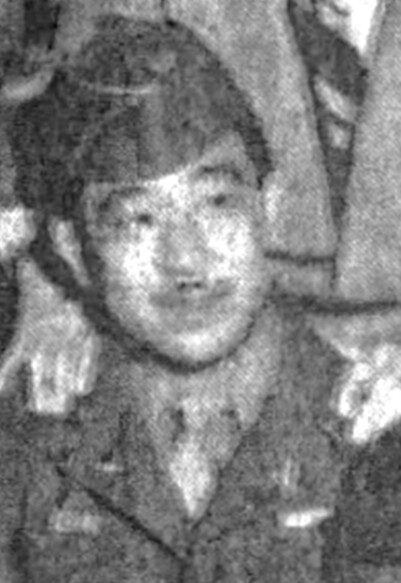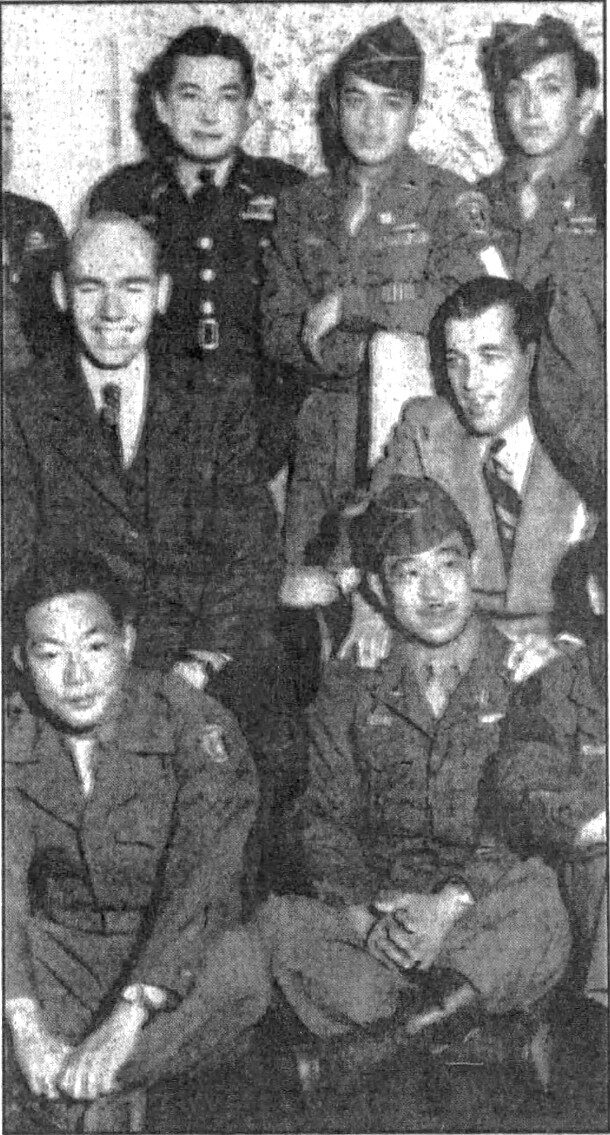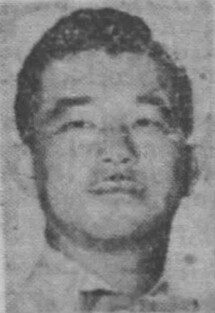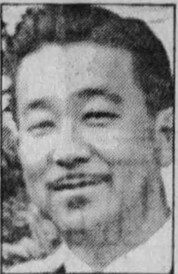Soldier Story: Edward Kiyoshi Tsubata
Soldier Story

Edward Kiyoshi Tsubata
Private First Class
3rd Battalion, Headquarters Company
442nd Regimental Combat Team
Edward Kiyoshi Tsubata was born on July 1, 1919, in Waialua, Oahu, Territory of Hawaii, to Daiji and Tsumoru (Minami) Tsubata. His siblings were: brother Marty Matsatsugu, and sisters Hatsuko and Aiko. Daiji arrived in 1899 from the village of Haramizu, Kumamoto Prefecture, Japan. Tsumoru arrived on the S.S. Asia on October 21, 1907, from Haramizu where she was living in the home of Noboru Tsubata.
When father Daiji signed his World War I draft registration card in 1918, he and his family were living in Haleiwa and he worked for the Waialua Agricultural Company.
In 1930, the family was living at Two Bridge in the village of Waialua. Father Daiji was a house carpenter for the sugar plantation and mother Tsumoru was a retail merchant in general merchandise. Kiyoshi was a member of the Pierce Boy Scouts of America. On August 13, 1937, Daiji died in the Japanese hospital in Honolulu, He was a recently retired longtime employee of Waialua Sugar Plantation.
Kiyoshi attended Alexander Cox Middle School in Waialua – where in 1933 he was art editor of the school newspaper, The Waialuan. On June 4, 1937, he graduated from Leilehua High School in Wahiawa. He was a member of the Haleiwa Hi-Y Boys Club.
In April 1940, widowed Tsumoru and two of her children were living on Kamehameha Highway in Haleiwa. Tsumoru was the proprietor of a retail dry goods/general store, Aiko was a dressmaker at a tailor shop, and Kiyoshi was working as a gas station attendant. He was a member of the Waialua baseball team in the West Oahu Japanese Junior League. In 1941, he was on the Board of Directors of the Haleiwa YMA (Young Men’s Association).
On September 18, 1942, it was reported in the Honolulu Star-Advertiser that over 600 employees of the Waialua Sugar Plantation had solicited donations and given $2,809.29 raised in a 2-week fundraising drive to the American Red Cross to support their work. This was done as a patriotic gesture to show their support of their adopted country in the war. The group of solicitors was named the Victory Unit – and Eddie Tsubata was a member and contributor.
Eddie, as Kiyoshi was known, signed his draft registration card on October 26, 1940, Local Board No. 11, at the Waialua Fire Station. His point of contact was his mother, and they lived in Waialua. He was employed at Service Motor Companies Ltd., P.O. Box 192, Wahiawa. He was 5’5¼” tall and weighed 130 pounds.
On October 26, 1941, Kakuo and Ichino (Kanno) Takahashi of Waialua announced the engagement of their daughter Frances Harue to Edward Kiyoshi Tsubata at a tea held in the home of Reverend and Mrs. Henry I. Ishimura. The Takahashis had emigrated from Miyagi Prefecture, Japan. On January 6, 1942, the couple applied for their marriage license. They were married on January 11 by Rev. Ishimura at the Christian Church in Waialua. The couple lived in Waialua where Eddie was on the Board of Directors of the Waialua Civic Club.
Edward K. Tsubata enlisted in the U.S. Army on March 23, 1943, in Honolulu. His civilian occupation was listed as “Carpenters.” He was sent to the “tent city” known as Boom Town with the other new soldiers at Schofield Barracks. On March 28, they were given an aloha farewell ceremony at Iolani Palace, prior to departing on April 4 on the S.S. Lurline for California. After they arrived at Oakland, they traveled by train to Camp Shelby, Mississippi.
The new soldiers of the 442nd RCT were assigned to companies prior to the commencement of basic training. Eddie was assigned to 3rd Battalion, I Company. However, upon learning that he was the father of a child, his daughter Grace, he was reassigned to 3rd Battalion’s Headquarters Company. While he was at Camp Shelby, he celebrated his 24th birthday on July 1, 1943. His wife contacted Lt. K. Akamatsu and Chaplain John T. Barrett and asked them to arrange for a birthday cake as a “token of her love.” The two officers set up a surprise party and huge decorated birthday cake for Tsubata.
After a year of basic, unit, and combat training, including field maneuvers, the 442nd left by train from Camp Shelby to Camp Patrick Henry, Virginia, on April 22, 1944. They then sailed in a convoy of about 100 ships from nearby Hampton Roads on May 2.
After a long sea voyage, the 442nd arrived at Naples, Italy, on May 28. After 10 days in bivouac at Staging Area No. 4 in the suburb of Bagnoli, they left on June 6 by LSTs and LCIs for the overnight trip to the recently liberated Anzio beachhead. A few days later, on June 9, the 442nd convoyed through the also newly liberated city of Rome to a large bivouac near Civitavecchia for final preparations to move to the front lines.
After serving in the Rome-Arno Campaign, where they entered combat near Suvereto on June 26, 1944, Pfc. Tsubata went to France on September 17 for the 442nd’s participation in the Rhineland-Vosges Campaign. During the ferocious fighting in the heavily forested mountains of the Vosges, Pfc. Tsubata saw combat in the liberation of the important road and rail town of Bruyères and neighboring village of Biffontaine and the Rescue of the Lost Battalion.
Due to heavy casualties in the Vosges, which resulted in the 442nd falling below combat strength, they were sent to southern France for the Rhineland-Maritime Alps Campaign from November 21, 1944, to March 17, 1945. This was mostly a defensive position to guard against enemy incursion along the French-Italian border. While the 442nd was in Sospel during the Champagne Campaign, Eddie was the driver for 2nd Lieutenant Bernard Perlsweig. In later years, Eddie’s eldest child recalled that Perlsweig told her that her father was his driver who “really knew the terrain speeding up and down the hills of Sospel and L’Escarène, France, where he had to hang on for his life in the Jeep.” Perlsweig was wounded and lost a leg during the war. He communicated with many of his men and brought his wife and son to the 442nd’s 50th anniversary reunion in Honolulu.
On March 20-22, 1945, the 442nd (without its 522nd Field Artillery Battalion who were sent to Germany) left France to fight in the Po Valley Campaign for the final push to defeat the Nazis in Italy. They arrived at the Peninsular Base Section in Pisa on March 25 and were assigned to Fifth Army, 92nd Division.
The objective of the 442nd was to execute a surprise diversionary attack on the western anchor of the German Gothic Line. This elaborate system of fortifications had been attacked repeatedly in the fall of 1944, but no one had yet been able to pry the Germans loose from the western end. The Gothic Line in this area was hewn out of solid rock, reinforced with concrete, and constructed to give all-around protection and observation. The Germans were dug into mountain peaks rising almost sheer from the coastal plain, bare of vegetation save for scanty scrub growth.
The Combat Team left their initial staging area and moved to a bivouac at San Martino, near the walled city of Lucca. Starting on April 3, the 442nd conducted a surprise attack on the Germans at Mount Folgorito. Under cover of darkness to maintain their secrecy, Tsubata’s 3rd Battalion and the 100th Battalion were trucked 17 miles to assembly areas at Pietrasanta in the foothills. The regimental Command Post was set up at Vallecchia and the rifle company men ascended on foot eight miles up the mountain to the town of Azzano, closing in at 4:00 a.m. on April 4. All moves were carried out in the utmost secrecy.
On the night of April 4, after spending the day hiding in homes in Azzano, the men of 3rd Battalion’s attacking companies I and L, supported by the machine guns of M Company, moved down the steep mountainside of Azzano to the bottom, and then back up the other side – an almost perpendicular slope up Mt. Carchio and Mt. Folgorito. Twelve litter-bearer relay points were set up from the bottom to the crest of the Carchio-Folgorito ridge. In addition, 3rd Battalion’s Ammunition and Pioneer Platoon from Headquarters Company was attached to the attacking companies to sweep the terrain in front for booby traps and mines.
Once at the top of the mountain, the men of 3rd Battalion enveloped Mt. Folgorito from the east and north, and sent one company along another ridge at Mt. Cerreta to join with the 100th Battalion attacking directly head on from the south and another 3rd Battalion company continued the attack on Mt. Carchio.
On April 5 the surprise attack was a stunning success. The sleeping Nazis were quickly overwhelmed and the vaunted Gothic Line was cracked in 90 minutes after resisting other unsuccessful attempts over a five-month period by the 92nd Division while the 442nd was fighting in France.
The next day, April 6, starting under cover of darkness, there followed intricate coordination between the three infantry battalions of the 442nd. The 3rd Battalion’s Command Post was located in the foothills. As a member of Headquarters Company, Pfc. Tsubata was called upon occasionally to serve on the front lines with the rest of 3rd Battalion.
After continuously pushing the Nazis north along the mountain peaks of the Apennines, the Germans finally surrendered in Italy on May 2, a full week before the surrender of the German Army in Europe.
During the occupation, the 442nd was in bivouac at Novi Ligure until May 16 when they left for Ghedi Airfield near Brescia. There, they processed and guarded thousands of German POWs for a month. They next moved to Lecco on Lake Garlate. While there, they enjoyed Lake Como and the beautiful countryside. In early July they were sent to the vicinity of Livorno, Pisa, and Florence where they would stay for the rest of their occupation duties of guarding prisoners and military installations. During this time, soldiers were being sent back to the US on a point system, with high pointers leaving first. Points were given factors such as months of service in theater, number of times wounded, number of dependents at home.
Pfc. Tsubata left Italy and was in New York City for a brief visit before he headed on to California and home. While in New York, he and some buddies were entertained by radio host Ed Sullivan and Earl Finch, the man from Hattiesburg, Mississippi, who had befriended the 442nd soldiers at Camp Shelby and remained their good friend and benefactor.
Tsubata returned to Honolulu on the USAT Evangeline with about 850 other veterans on December 19, 1945. After debarking at Pier 26, the men were given an hour to be greeted by the hundreds of family and friends. They were then taken by bus to the Army Separation Center at Fort Kamehameha for processing. Tsubata was discharged from the Army on January 3, 1946.
Below: In New York while enroute home, December 1945; top row far left Lt. Daniel Inouye; middle row left to right Earl Finch, Ed Sullivan; seated, far right Pfc. Tsubata

For his military service, Pfc. Edward Kiyoshi Tsubata earned the: Purple Heart Medal, Bronze Star Medal with oak leaf cluster, Good Conduct Medal, European-African-Middle Eastern Campaign Medal with four bronze stars, World War II Victory Medal, Army of Occupation Medal, Distinguished Unit Badge, and Combat Infantryman Badge. He also received a special medal from the city of Bruyères, France. Tsubata was posthumously awarded the Congressional Gold Medal on October 5, 2010, along with the other veterans of the 442nd Regimental Combat Team. Conferred by the U.S. Congress, the award states: “The United States remains forever indebted to the bravery, valor, and dedication to country these men faced while fighting a two-fronted battle of discrimination at home and fascism abroad. Their commitment and sacrifice demonstrate a highly uncommon and commendable sense of patriotism and honor.”
After his discharge, Eddie and Frances moved into Aiea Veterans Housing. By 1949, they were living at 1724-A Algaroba Street and he was employed as a typist for the 51st Quartermaster Department. Over the years they raised a family of one daughter and two sons. They were both active in the 442nd Veterans Club, where Eddie was on their softball and golf teams. He also enjoyed fishing with family and friends.

In the September 16, 1951, Honolulu Star-Advertiser, it was announced that Edward Tsubata had joined the staff of American-Hawaiian Motors as a salesman. He was previously employed for 4½ years with Hawaiian Plumbing and Sheet Metal Works and later was a sales promotional representative with Consolidated Dairy Product Company of Seattle, Washington.
In December 1951, the new house that Eddie and Frances had constructed was completed. It was built by Edward N. Kanno at 2566 Ahekolo Street in Honolulu.

Edward Kiyoshi Tsubata died at the age of 67 on November 28, 1986, in Honolulu. His memorial service was held at Nuuanu Congregational Church, 2561 Pali Highway, on December 4. He was buried with full military honors on December 5 in the National Memorial Cemetery of the Pacific at Punchbowl, Section H, Site 876A.
Right: Photo that appeared in Tsubata’s obituary
He was a retired sales representative. Survivors included his wife, daughter Grace T., and sons Keith A. and David T. His wife Frances died on September 11, 2009, and was buried next to her husband. She was a retired State Labor Department employment specialist. Survivors included her three children, five grandchildren, and two great-grandchildren.
On December 17, the family printed a Card of Thanks in the Honolulu Star-Bulletin expressing their gratitude to relatives, friends, and various organizations for the beautiful floral offerings, monetary gifts, and kind expressions of sympathy received during their recent bereavement.
Researched and written by the Sons & Daughters of the 442nd Regimental Combat Team in 2025 with assistance from his daughter Grace Tsuyuko Tsubata Fujii, a Lifetime Member who was instrumental in the formation of the 442nd Sons & Daughters.